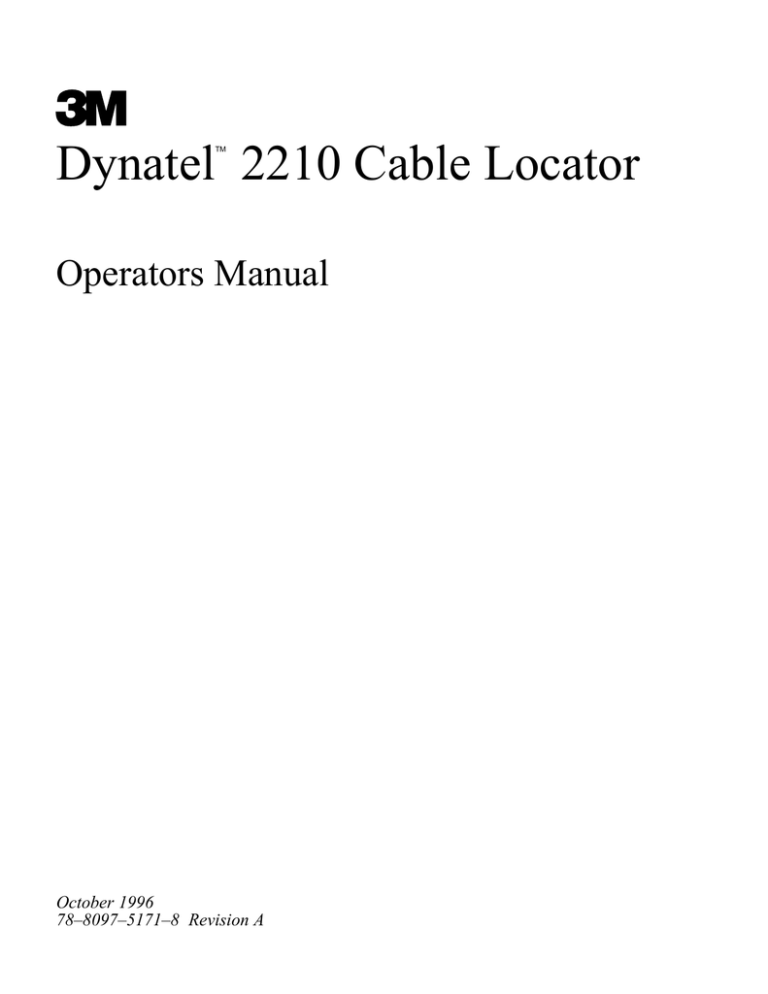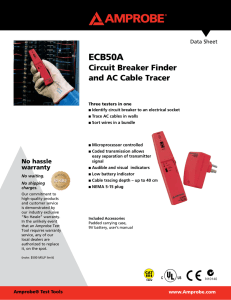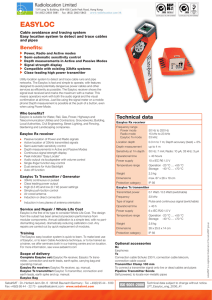DynatelTM 2210 Cable Locator
advertisement

Dynatel 2210 Cable Locator TM Operators Manual October 1996 78–8097–5171–8 Revision A 3M Dynatel 2210 Cable Locator TM TM Operators Manual The information in this manual is proprietary to 3M and may not be reprinted or otherwise copied without the express written permission of 3M. 1996 3M Table of Contents Introduction . . . . . . . . . . . . . . . . . . . . . . . . . . . . . . . . . . . . . . . . . . . . . . . . . . . . . . . . . . . . . . . . . . . 1 Installing or Replacing the Batteries . . . . . . . . . . . . . . . . . . . . . . . . . . . . . . . . . . . . . . . . . . . . . . 1 Initial Receiver Configuration . . . . . . . . . . . . . . . . . . . . . . . . . . . . . . . . . . . . . . . . . . . . . . . . . . . . 1 Receiver Battery Test . . . . . . . . . . . . . . . . . . . . . . . . . . . . . . . . . . . . . . . . . . . . . . . . . . . . . . . . . . . 2 Transmitter Battery Test . . . . . . . . . . . . . . . . . . . . . . . . . . . . . . . . . . . . . . . . . . . . . . . . . . . . . . . . 2 Locating a Buried Cable . . . . . . . . . . . . . . . . . . . . . . . . . . . . . . . . . . . . . . . . . . . . . . . . . . . . . . . . 2 Direct Connect Method . . . . . . . . . . . . . . . . . . . . . . . . . . . . . . . . . . . . . . . . . . . . . . . . . . . . . . 3 Dyna-Coupler Method . . . . . . . . . . . . . . . . . . . . . . . . . . . . . . . . . . . . . . . . . . . . . . . . . . . . . . . 4 Induction Method . . . . . . . . . . . . . . . . . . . . . . . . . . . . . . . . . . . . . . . . . . . . . . . . . . . . . . . . . . . 4 Locating a Buried Cable . . . . . . . . . . . . . . . . . . . . . . . . . . . . . . . . . . . . . . . . . . . . . . . . . . . . . . . . 5 About Trace Modes . . . . . . . . . . . . . . . . . . . . . . . . . . . . . . . . . . . . . . . . . . . . . . . . . . . . . . . . . 5 Determining Cable Depth and Current . . . . . . . . . . . . . . . . . . . . . . . . . . . . . . . . . . . . . . . . . 6 Locating Sheath Faults . . . . . . . . . . . . . . . . . . . . . . . . . . . . . . . . . . . . . . . . . . . . . . . . . . . . . . . . . 6 Locating an Active Duct Probe (ADP) . . . . . . . . . . . . . . . . . . . . . . . . . . . . . . . . . . . . . . . . . . . . 7 Locating EMS Markers . . . . . . . . . . . . . . . . . . . . . . . . . . . . . . . . . . . . . . . . . . . . . . . . . . . . . . . . . 8 Toning Aerial faults . . . . . . . . . . . . . . . . . . . . . . . . . . . . . . . . . . . . . . . . . . . . . . . . . . . . . . . . . . . . . 8 Cable or Pair Identification . . . . . . . . . . . . . . . . . . . . . . . . . . . . . . . . . . . . . . . . . . . . . . . . . . . . . . 9 Technical Information . . . . . . . . . . . . . . . . . . . . . . . . . . . . . . . . . . . . . . . . . . . . . . . . . . . . . . . . . . 11 Transmitter . . . . . . . . . . . . . . . . . . . . . . . . . . . . . . . . . . . . . . . . . . . . . . . . . . . . . . . . . . . . . . . . 11 Receiver . . . . . . . . . . . . . . . . . . . . . . . . . . . . . . . . . . . . . . . . . . . . . . . . . . . . . . . . . . . . . . . . . . 11 Environmental . . . . . . . . . . . . . . . . . . . . . . . . . . . . . . . . . . . . . . . . . . . . . . . . . . . . . . . . . . . . . 11 Physical . . . . . . . . . . . . . . . . . . . . . . . . . . . . . . . . . . . . . . . . . . . . . . . . . . . . . . . . . . . . . . . . . . 11 Optional Accessories . . . . . . . . . . . . . . . . . . . . . . . . . . . . . . . . . . . . . . . . . . . . . . . . . . . . . . . . . . 12 This manual has been prepared to provide the most important written instruction material to date for this product. It assumes a basic understanding of the commonly used terms in telephone transmission and switching. Whenever this manual is reissued, the reason(s) for reissue will be listed here. Comments concerning the contents or organization of this document, as well as suggestions for improvement are welcomed. Direct comments to: 3M Telecom Systems Division Lab – Technical Communications 6801 River Place Boulevard Austin, Texas 78726–9000 For Technical Service call: 800/426 8688 (outside the U.S.A. call 512/984 2575) Dynatel is a Trademark of 3M Dyna-Coupler is a Trademark of 3M Duracell is a registered trademark of Duracell Inc. i SET UP (USE ONE OF THREE METHODS) Prepare the transmitter using one of the three following methods: Direct Connect Induction Dyna-Coupler Go to Transmitter Operation to turn the unit on and apply tone to the cable. Refer to Receiver Operation to prepare the receiver and locate the cable. For passive power locating, go directly to Receiver Operation. Note: For more detailed locating instructions and advanced locating techniques, ask your 3M sales representative for a publication called Cable and Pipe Locating Techniques. Transmitter Set Up: Direct Connect Method Far End Ground Note: Never connect ground to water pipe or other services in the area. The return signal may mislead the trace. Suspected Cable Path Black Clip to Ground Rod Red Clip to Shield Remove Near End Ground Transmitter CAUTION: Check for stray voltages before attaching transmitter. Voltage higher than 240 volts (AC/DC) damages equipment. Follow standard procedures for reducing voltage. 1. With the transmitter off, plug the direct connect cable into the transmitter front panel jack. 2. Connect the black clip to the ground rod. 3. Place the ground rod in the earth as far from the near end connection as the leads will allow, at a 90– degree angle to the suspected cable path. 4. Remove the near-end shield bond; connect the red clip to the shield. Induction Method Transmitter Hinge Near End Ground Suspected Cable Path Far End Ground 1. Place the transmitter on the ground over the target cable with the lid hinge in line with the cable path. Dyna-Coupler Method (Optional Accessories Required) Pedestal To Transmitter Note: The coupler jaws must fully close for tone transmission. Suspected Cable Path Transmitter 1. Plug the Dyna-Coupler into the cable (optional accessories). Plug the cable into the transmitter front panel jack. 2. Clamp the Dyna-Coupler around the cable below any bonds just before the cable enters the earth. Note: Dyna-Coupler jaws must be fully closed. Transmitter Operation: 1. Hold down batteries). for Battery Test (solid tone=good; beeping tone=low; no tone=replace to turn the unit on and select Continuity Test (solid tone=good ground; beeping 2. Press tone= usable ground; no tone=poor ground or no far end ground). Both LEDs light continuously during the continuity test. to apply Tracing Tone and select the desired frequency: 577 Hz for direct 3. Press connect with far end ground; or 33 KHz for direct connect with no far end ground, or for use with coupler, or induction. LED indicates frequency selection. (This key can also turn the unit on.) to change output level. Choose Normal output (flashing LED) for locating short 4. Press to moderate distances using direct connect method. Use High output (solid LED) for coupler, induction, or direct connect for long distance. 5. When locating is complete, press 2 to turn the unit off. Receiver Operation: 2210 577 Hz Receiver Front Panel 33 KHz Gain Adjust to turn receiver on and see battery level. Hold down for continuous Battery 1. Press Test. If bar graph is to the left of the battery level mark, replace batteries. Note: when remains on. batteries are low, the battery test indicator 2. Press to match Frequency to transmitter output or select locating. for passive power 3. Press to set Gain when bar graph is not visible or is closed. For High Volume ( ), hold down while turning unit on. To return to normal volume, turn unit off, then on again. 4. Make broad sweeps with receiver handle in line with target cable path to get maximum bar graph closure; press . Maximum bar graph and numeric indication occurs directly over cable. 5. Place the receiver upright on the surface directly over cable. With handle parallel to path, press to display estimated Depth. Press again to display numeric Current indication. Cable with highest current indication is the target. Press to return to trace mode, and press . Unit returns to trace mode automatically after eight seconds. Note: Active Duct Probe (sonde) depth will differ from cable depth due to the shape of the electromagnetic field of the ADP. Conversion tables are provided with the ADP to obtain accurate depth estimates. Battery Installation 6 ‘C’ cells 6 ‘AA’ cells 3 Technical Information: Active Frequencies: 574.9 Hz and 32768 Hz (Actual) Passive Frequency: 50/60 Hz Power Battery Life: Receiver: 84 hours, typical (Normal audio level) Transmitter: 50 hours, typical (Normal output) 10 hours, typical (High output) Recommended Batteries: Duracell MN1500 AA Alkaline Duracell MN1400 C Alkaline Temperature Range: Operating: -4°F to 122°F (-20° to 50°C) Storage: -40°F to 158°F (-40° to 70° C) (remove batteries for long-term storage) Receiver Weight: 3 lbs. 14 oz. (1.75 kg) Transmitter Weight: 5 lbs. 9 oz. (2.52 kg) Optional Accessories: 3” Dyna-Coupler Kit: 3019 (includes 3” Dyna-Coupler, Cable and Accessory Pouch) 1” Dyna-Coupler: 3005 6” Dyna-Coupler: 1196 (includes 6” Dyna-Coupler and Pouch) Active Duct Probe 3229 4 IMPORTANT NOTICE: Before utilizing the product the user should determine the suitability of the product for its intended use. The user assumes all risks and liability whatsoever in connection with such use. 3M’s WRITTEN WARRANTY FOR THE PRODUCT IS MADE IN LIEU OF ALL OTHER WARRANTIES, EXPRESSED OR IMPLIED, INCLUDING BUT NOT LIMITED TO THE IMPLIED WARRANTIES OF MERCHANTABILITY AND FITNESS FOR A PARTICULAR PURPOSE. The user’s exclusive remedy for breach of 3M’s written warranty shall be the repair or replacement of such quantity of product which is proven to be defective. In no case shall 3M be liable for any special, incidental, or consequential damages based upon breach of warranty, breach of contract, negligence, strict liability or any other legal theory. Telecom Systems Division 6801 River Place Blvd. Austin, Texas 78726–9000 Litho in USA. 3M 1996



